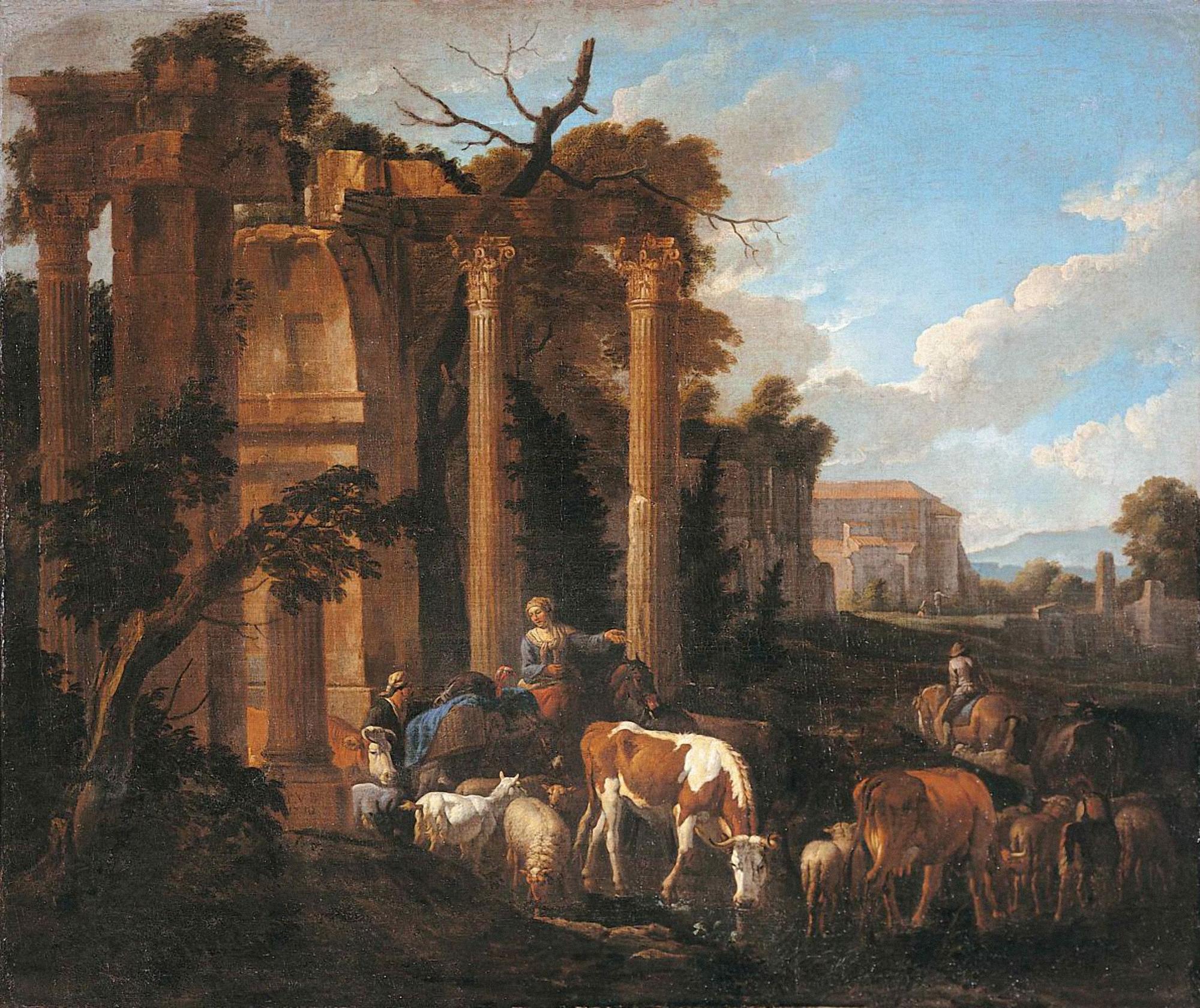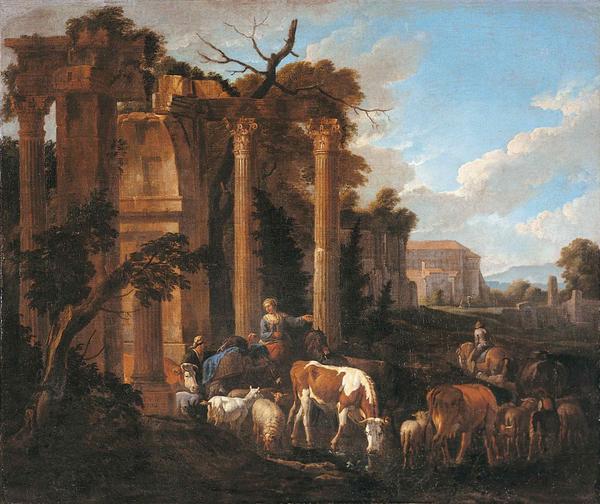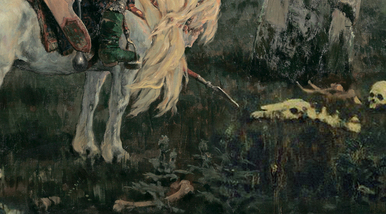Three van Bloemen brothers marked a place for themselves in the history of art: the junior brother Norbert, nicknamed Cephalus, the middle brother Jan Frans, or Horizon, and their senior brother Pieter also known as Standaard. The latter received his nickname in his youth as he was fond of drawing flags, coats of arms and regiment colours.
Historical or military motifs, admittedly, are present in the artist’s mature works, even though they contain nostalgic and sarcastic notes. The Watering Place near Ancient Ruins may serve as an example of the artist’s development in that direction.
At first sight one may think that Pieter van Bloemen used canvas and oil to depict a pastoral landscape: a blue sky and clouds are visible in the background, and the foreground shows a small herd near a watering hole. Horses, cows, sheep and goats seem calm and indifferent to the environment. Only a turkey cock sits proudly in a basket on the back of a donkey that passes under a ruined arch.
At this point, things take on a deeper meaning. It is a fact that triumphal arches were erected in honour of winners and events in the most important city points: entry points, bridges or squares. However, in the picture all one can see are crumbling buildings and wilting vegetation: a damaged column and a dry tree are placed virtually in the center of the composition.
Thus, the master of the 18th century demonstrated how passing years could turn a civilization into a wasteland. Only the outlines of massive stone structures in the distance remind one of Rome’s former splendour. The fate of the empire was so tragic that architecture failed to become a revered memorial for the future generations and merely serves as a source of water and shade for cattle.
Art critics, however, maintain that Pieter van Bloemen perceived time as a process of transition from the dark past to a bright future. The arrangement of the colour scheme in the painting may well confirm the point. The woman’s gesture and the direction of the moving animals also hint at the artist’s optimism.
It is worth mentioning that the artist’s ‘punch line’ was to demonstrate scenes, which were typical of the Flemish art school, against the background of ancient ruins. That is largely due to the fact that the painter spent a lot of time both in Belgium and in Italy.
Among other things, European art experts highly praise animalistic images in his works. Numerous sketches and paintings depict horses, cattle, dogs or birds in difficult positions. The Caravan is on display at the Prado National Museum in Spain, the Riding School among Roman Ruins can be seen at the German Gallery of Old Masters, and the Cattle Drive is exhibited at the Norwegian National Museum of Art.
Historical or military motifs, admittedly, are present in the artist’s mature works, even though they contain nostalgic and sarcastic notes. The Watering Place near Ancient Ruins may serve as an example of the artist’s development in that direction.
At first sight one may think that Pieter van Bloemen used canvas and oil to depict a pastoral landscape: a blue sky and clouds are visible in the background, and the foreground shows a small herd near a watering hole. Horses, cows, sheep and goats seem calm and indifferent to the environment. Only a turkey cock sits proudly in a basket on the back of a donkey that passes under a ruined arch.
At this point, things take on a deeper meaning. It is a fact that triumphal arches were erected in honour of winners and events in the most important city points: entry points, bridges or squares. However, in the picture all one can see are crumbling buildings and wilting vegetation: a damaged column and a dry tree are placed virtually in the center of the composition.
Thus, the master of the 18th century demonstrated how passing years could turn a civilization into a wasteland. Only the outlines of massive stone structures in the distance remind one of Rome’s former splendour. The fate of the empire was so tragic that architecture failed to become a revered memorial for the future generations and merely serves as a source of water and shade for cattle.
Art critics, however, maintain that Pieter van Bloemen perceived time as a process of transition from the dark past to a bright future. The arrangement of the colour scheme in the painting may well confirm the point. The woman’s gesture and the direction of the moving animals also hint at the artist’s optimism.
It is worth mentioning that the artist’s ‘punch line’ was to demonstrate scenes, which were typical of the Flemish art school, against the background of ancient ruins. That is largely due to the fact that the painter spent a lot of time both in Belgium and in Italy.
Among other things, European art experts highly praise animalistic images in his works. Numerous sketches and paintings depict horses, cattle, dogs or birds in difficult positions. The Caravan is on display at the Prado National Museum in Spain, the Riding School among Roman Ruins can be seen at the German Gallery of Old Masters, and the Cattle Drive is exhibited at the Norwegian National Museum of Art.



